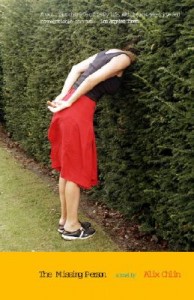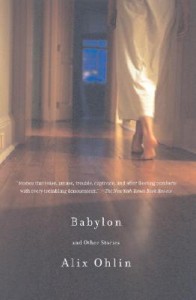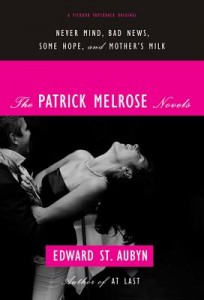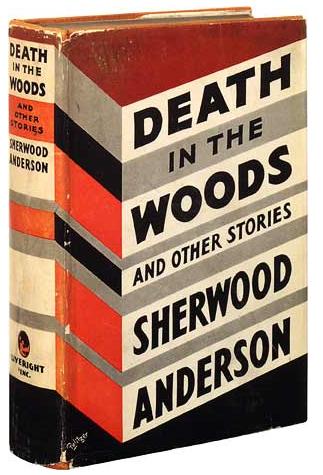Alix Ohlin’s novel Inside (Knopf) and her story collection Signs and Wonders (Vintage) were both published on June 5, 2012. She is also the author of The Missing Person, a novel, and Babylon and Other Stories. Her work has appeared in Best American Short Stories, Best New American Voices, and on public radio’s Selected Shorts. Born and raised in Montreal, she currently lives in Easton, Pennsylvania, and teaches at Lafayette College and in the Warren Wilson MFA Program for Writers.
I teach at Warren Wilson with Alix Ohlin, and over the course of two intensive ten-day residencies I have often marveled at the insight she displays when discussing the work of others—whether we’re talking about literary greats or up-and-coming graduate students. She is simply one of the most intelligent readers I have ever met, and the classes she teaches at Warren Wilson are wonderful hybrids of practical advice and theoretical speculation. Our informal conversations are often incredibly inspiring as well, but every time they end I always realize I’ve ended up talking about my own work, and Alix has revealed nothing of hers. Perhaps this is because I am a narcissist, or perhaps it’s because Alix, despite her blazing brightness, is also a humble, thoughtful, and gracious colleague. I used the recent publication of her two new books as an excuse to get her to talk about her own work.
Interview
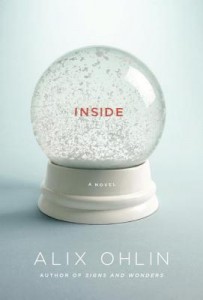 Dean Bakopoulos: I want to begin by talking about the canvas of your novel, Inside. By that I mean the landscapes it inhabits, the characters and settings and story lines. It’s a big canvas–there are a lot of vistas in it, multiple threads. Did you start out wanting to write a novel of this scope? Or did it snowball from one small story into many?
Dean Bakopoulos: I want to begin by talking about the canvas of your novel, Inside. By that I mean the landscapes it inhabits, the characters and settings and story lines. It’s a big canvas–there are a lot of vistas in it, multiple threads. Did you start out wanting to write a novel of this scope? Or did it snowball from one small story into many?
Alix Ohlin: My first book was a coming-of-age story narrated by a single person, set in one place, over the course of a single summer. I chose these confinements as a way of coping with my intense, heart-racing anxiety over writing a novel, thinking it would make the project more manageable. For this second book, I wanted to try something different, and the larger canvas, fractured chronology, and multiple story lines felt like an intriguing (at times impossible) risk to take. And I liked how the ideas in the book, which are about helping and connection, were configured and reconfigured by their various appearances in the lives of all the different characters. It seemed to turn the novel into a kind of echo chamber, and I liked that.
That said, the story did start from one small scene: the moment that opens the novel, when a woman who is cross country skiing comes across a man who has just tried to hang himself, and decides that she wants to help him. That scene gripped my imagination for whatever reason, and every time I lost the thread of the novel, or contemplated giving it up, I’d return to that place—the very, very beginning—and start over.
As a writer, do you have favorites? Is there a character in your multiple-character novel who feels like the heart of Inside to you? Is there a character who you identify with on some visceral, personal level?
I don’t have favorites, and I identify with all the characters, even the minor ones, even those who are extremely different from myself; I have to identify with them in order to write them. But I will say that with Inside, the heart of the novel for me is Grace, the therapist who stumbles upon a would-be suicide on a winter day in Montreal. This is the collision that sets the book into motion: a compulsive helper meeting a person in crisis. Throughout the many false starts and different drafts of the book, I always saw that opening scene—the silvery light of Montreal at dusk, a man lying silent in the snow—vividly. It gripped my imagination and whenever I felt lost in the novel, or confused as to what the whole thing was about, I would return to that place and start over.
That said, the character of Anne, a manipulative, poorly-behaved actress who gradually lets go of her narcissism and learns to care about other people, was the most fun to write. She says and does some outrageous things and there was a lot of vicarious enjoyment in that for me, an acting out in fiction of things I would never do in my own life.
In your story collection, Signs and Wonders, one thing I notice is a feeling of effortlessness in each story, as if the stories arrived in your imagination wholly and completely. Of course, I know this can’t be true. But tell me, which story “arrived” most easily for you? And which story seemed to be excruciatingly difficult for you? Which one took the most drafts to get right?
There are for me, very occasionally, stories that arrive as gifts from the universe, almost whole and complete in the early drafts. I emphasize that this happens rarely. I like to believe these are rewards for all the hours otherwise spent slogging through drafts. I do think these tend to be my best stories and in this collection, the title story “Signs and Wonders” came like that. I had been collecting and saving various elements of it in my head for years like a magpie—an anecdote told to me by my hairdresser, a brief news story about a car jacking I read in an obscure newspaper, a line of description I’d thought of but never used—and suddenly they all clicked together in my mind.
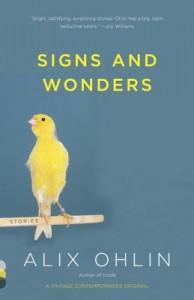 By contrast, “The Cruise,” about a woman who takes a trip to the Galapagos with her aunt, was a draft that I wrote about half of and then got completely stuck. I set it aside for a year, maybe more. Then I rediscovered the file on my computer and decided to finish it. I had stopped working on it because I couldn’t think of a major plot event to bring the story to completion. It’s about a woman whose mind is in turmoil from divorce and I thought some kind of wacky hijinks had to ensue to shake her out of it. I kept casting about for serious narrative fireworks, the potential ideas growing ever more ludicrous and terrible—a fire! An animal rampage! Salmonella! (This was before the Italian cruise ship accident, otherwise I would probably have tried to work that in somehow.)
By contrast, “The Cruise,” about a woman who takes a trip to the Galapagos with her aunt, was a draft that I wrote about half of and then got completely stuck. I set it aside for a year, maybe more. Then I rediscovered the file on my computer and decided to finish it. I had stopped working on it because I couldn’t think of a major plot event to bring the story to completion. It’s about a woman whose mind is in turmoil from divorce and I thought some kind of wacky hijinks had to ensue to shake her out of it. I kept casting about for serious narrative fireworks, the potential ideas growing ever more ludicrous and terrible—a fire! An animal rampage! Salmonella! (This was before the Italian cruise ship accident, otherwise I would probably have tried to work that in somehow.)
And then, looking at the story a year later, I decided not to go that route—there would be no major plot event at all. Instead there would be a gradual quieting of the story; even the syntax of the sentences would simplify, until her emotions calmed and her focus broadened and she was finally able to see outside herself, at the world around her. It was the absolute opposite of the story I originally set out to write, a betrayal of all my earlier instincts, and I felt it worked.
Finishing is always the hardest part, I think. Knowing when you’ve reworked something in the right way, when it’s done. I tend to work on multiple things at once, and when they near completion, all of sudden, I have to choose one to focus on and finish and it is exhausting. Is that how you work? The subtext of my question is one a lot of writers might want me to ask you: How the f**k do you publish two books at once?
The publication of two books at the same time is a bit deceptive, since they both represent work spread over many years, with lots of stops and starts. It’s not like I sat down with two piles of paper and wrote a novel with my right hand and stories with my left. Although that would be a good stunt. Anyway, I wrote the novel over the course of around five years, and at some points I was purely focused on it, and at other times I’d set it aside. When I wasn’t working on it, I was taking a break by writing short stories, or I was teaching or doing other stuff. I think one of the most underestimated tools of revision is time. With a novel especially, it’s so easy to get lost inside it, to become so confused and/or so entrenched in a particular path that you can no longer see the project clearly. But if you leave it alone for a month, or three months or six, when you come back to it you are likely to look at it in a fresher way. And for me, because the short stories represented a break from the novel, they usually felt like a release, which probably made them more playful and energetic. So the dual-project system actually made writing more logistically and emotionally manageable for me, not less.
You teach at a liberal arts college and at Warren Wilson, as do I. And so I know how much time this can take, and how much of one’s energy has to go into teaching? Do you write when you’re in a heavy teaching semester? Does it feed your work or stifle it?
I rarely write during a heavy teaching semester, unless it’s a fairly short, contained piece like a review. I just don’t have the creative energy to do both, though I certainly admire people who do. But that’s not to say that teaching doesn’t feed my work, because it does (and I’m not just saying that). It engages the critical side of my mind, which is significant, and it keeps me from being lazy, because I have to keep up with whatever my students are reading and I want to be a model of rigorous reading for them. And it also—this is not to be underestimated—gives me a sense of community and stability and faith. I have a lot of self-doubt when it comes to my own writing, and my feelings about it go up and down. But teaching is something whose value I believe in always. The nurturing of student work, the sharing of enthusiasm about other people’s books, participating in a larger conversation about literature—I always think that’s worthwhile. It keeps me on an even keel while my feelings about my own projects are all over the place. It’s ballast.
What are you working on now?
I’ve been writing a lot of loose, messy drafts that may or may not go anywhere. I’m always superstitious to say too much about them, because I find if I define the idea of a project too much in advance then it kind of collapses for me. It dies on the vine. I’ve also been doing research, which involves reading a lot of dystopian literature, artist biographies, and non-fiction books about mid-century New York. The three are not necessarily connected.
In addition to the strange assemblage of research I just mentioned, I’ve also recently read and enjoyed books by Clarice Lispector, Ben Lerner, and Edward St. Aubyn, whose Patrick Melrose novels are amazing—my favorite thing I’ve read this year.
Here’s something I’ve always wanted to ask you, and in the guise of a serious interviewer I may now ask it: I tell my students that most novels feel like they are falling apart around page 150, once the multiple story lines and intentions of the book begin to cross paths and demand significant attention. This is always, to me, when a book feels hopeless. You don’t seem as if you ever feel hopeless. You seem always poised and funny and in full control of your emotional impulses. Maybe it’s a Canadian or Swedish thing, all that clear-eyed control. But tell me: don’t you sometimes feel hopeless?
This question is hilarious to me. Of course I do, and more than sometimes. But Swedish-Canadians keep these things to themselves. I don’t ascribe the completion of my books to optimism or self-confidence, neither of which are qualities I possess in particular abundance. What I do have are stubbornness and an unshakable belief in the value of routine. Everything I’ve ever written is the result of gradual, daily, slow and steady accumulation of words. I start something, I hold on to it, and I don’t let it go.



